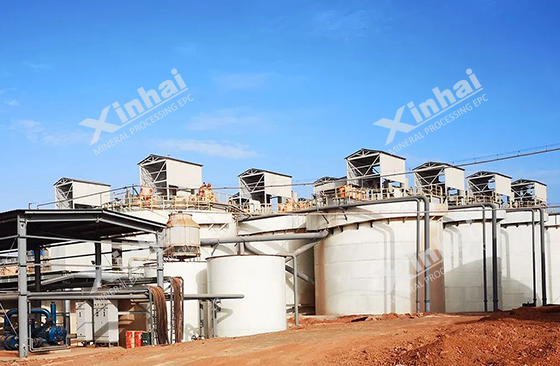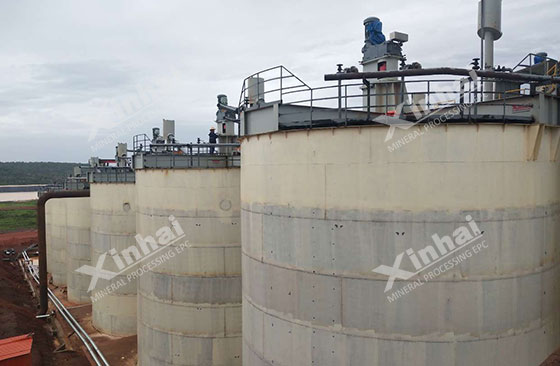If you want to know more information (such as product/process price, etc.), please contact us 24-hour telephone
A cyanidation plant refers to a facility that uses cyanide as the primary reagent for gold extraction. In such plants, gold is typically dissolved through cyanidation to form a soluble complex, which is then recovered either by activated carbon adsorption or zinc precipitation. This method represents the mainstream process for extracting gold from gold-bearing ores.
So, what exactly is the cyanidation process, and how should mineral processing equipment be configured accordingly?
Read on to find out.

The core process of gold extraction in a cyanidation plant is cyanide leaching. The principle of this process is to use sodium cyanide and other reagents to dissolve the gold in the ore, followed by activated carbon adsorption or other recovery methods. Common cyanide leaching methods include CIL (Carbon-in-Leach) and CIP (Carbon-in-Pulp).
Process Flow of Gold Extraction in a Cyanidation Plant:
Crushing → Grinding → Cyanide Leaching (CIL/CIP) → Carbon Adsorption → Desorption and Electrolysis → Smelting → Tailings Treatment
Detailed Process Description:
1. Ore Crushing and Grinding
The mined gold-bearing ore must first undergo crushing and grinding to reduce the particle size. Typically, the grinding fineness reaches 80% passing 0.074 mm, which increases the contact area between gold and the cyanide solution, enhancing leaching efficiency.

2. Cyanide Leaching
The ground slurry is pumped into leaching tanks, where sodium cyanide solution is added, and the slurry pH is adjusted to 10.5–11 using lime. Air or pure oxygen is introduced to accelerate the leaching reaction. The leaching duration typically ranges from 24 to 48 hours.
3. Activated Carbon Adsorption
CIP process: Activated carbon is added to the leaching tanks. It adsorbs dissolved gold from the slurry, forming gold-loaded carbon. After adsorption, the carbon is separated from the slurry using a carbon screen.
CIL process: Coconut shell activated carbon is added directly to the slurry. This type of carbon is preferred for its high activity, microporosity, wear resistance, and ease of regeneration. It adsorbs dissolved gold and silver ions, forming gold-loaded carbon.
The saturated loading capacity of activated carbon can reach 3–7 kg Au per ton of carbon, and the carbon is periodically screened and transferred to the desorption stage.
4. Desorption and Electrolysis
In Xinhai’s integrated system, a mixture of sodium cyanide and sodium hydroxide is used for high-temperature desorption and electrolysis of gold from the gold-loaded carbon.
Prior to desorption, wood chips and other debris are removed via a carbon washing unit. Then, Xinhai’s high-temperature, high-pressure desorption process is applied at 150°C and 0.5 MPa, enabling up to 99% gold desorption within 2–6 hours.
The resulting pregnant solution contains a high concentration of gold-silver cyanide complexes, with significantly reduced impurities, making it ideal for electrolytic gold recovery. Finally, Xinhai’s integrated desorption-electrolysis system yields high-purity solid gold in a safe and cost-effective manner.
.jpg)
5. Smelting into Ingots
After desorption and electrolysis, the resulting gold sludge contains residual impurities such as zinc and copper, which are removed using nitric acid or hydrochloric acid. Fluxes such as borax and quartz are added to the purified sludge, and smelting is carried out in an electric arc furnace at 1200°C, producing gold ingots with a purity of ≥99.5%.
6. Tailings Treatment
Cyanide tailings from the gold cyanidation process contain toxic cyanide residues and must be treated scientifically and safely. Common tailings treatment methods include:
Alkaline chlorination: Mainstream method, suitable for cyanide concentrations between 50–10,000 mg/L
INCO process (SO₂/air method): Suitable for high-concentration tailings (>100 mg/L)
Hydrogen peroxide oxidation: For medium to low concentrations (<500 mg/L)
Ozone oxidation: Suitable for low-concentration tailings (<200 mg/L)
1. Double-Impeller Leaching Agitation Tank
The ore slurry and sodium cyanide are thoroughly mixed in the leaching agitation tank, with multiple aeration points introduced during the leaching process to accelerate gold dissolution.
The double-impeller leaching tank ensures uniform agitation, low energy consumption, even aeration, and a long service life.
It is suitable for leaching, adsorption, and mixing operations when more than 90% of the ore particle size is -200 mesh, and the pulp concentration is less than 45%.
2. Desorption Electrolysis System
The desorption electrolysis system is used to extract gold from gold-loaded carbon under high-temperature and high-pressure conditions.
Under a temperature of 150°C and a pressure of 0.5 MPa, the gold desorption rate can exceed 98%.
Xinhai's desorption electrolysis system features a high degree of automation and is equipped with automatic pressure-limiting and pressure-release mechanisms and safety valves to enhance operational safety.

3. Zinc Powder Precipitation System
For gold ores with relatively high silver content, the zinc powder precipitation method can be used for gold recovery.
Step 1: Precious solution purification – Suspended solids are removed from the pregnant solution to avoid affecting gold sludge quality.
Step 2: Deoxidation – Dissolved oxygen is removed from the solution, as oxygen inhibits the gold-zinc replacement reaction.
Step 3: Zinc addition and precipitation – Zinc powder is added to the deoxygenated solution to trigger the replacement reaction. The equipment completes both precipitation and filtration to collect gold sludge.
4. Other Auxiliary Equipment
In addition to the above major equipment, a complete cyanidation plant also requires auxiliary machines such as jaw crushers, vibrating screens, ball mills, hydrocyclones, thickeners, and belt conveyors.
Conclusion
The above introduces the gold cyanidation process and the key equipment involved.
Xinhai Mining, with over 30 years of experience in gold ore processing, is committed to building efficient and advanced cyanidation plants for clients. We provide EPCM+O services, from mine to gold ingot.
If you are planning to build a gold cyanidation plant, feel free to contact us.